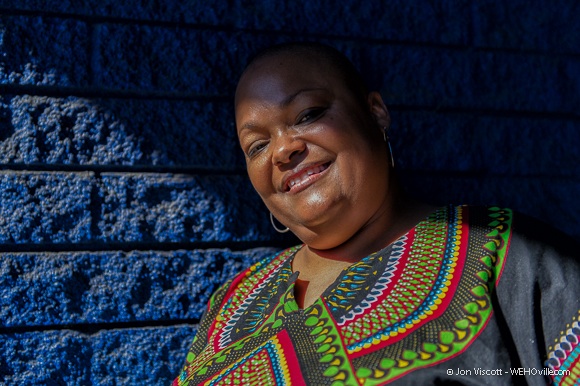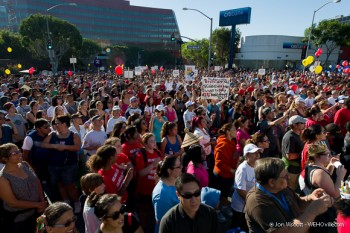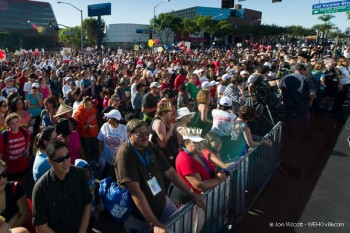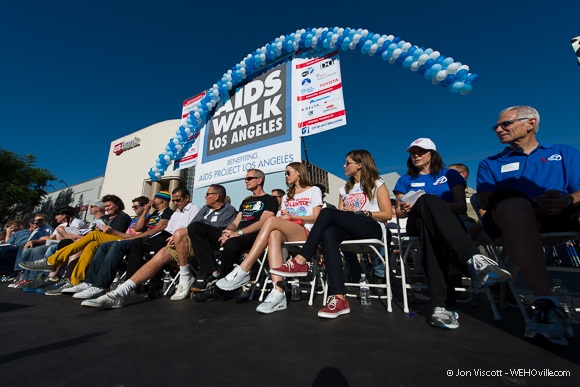
Eight years ago, Los Angeles resident LaVera Anom found out she was HIV positive.
The next few years “were like hell,” she said. “I wouldn’t talk to anyone. I cried every day. I hid my medicine in my own house, and I was living by myself with my son.
“I still hid it just in case I had a visitor over.”
Anom was ashamed that she had the disease. She didn’t think anyone would understand.
In 2008, everything changed, she said, when she began to get involved with AIDS Project Los Angeles (APLA), a non-profit AIDS service organization.
APLA provided her critical HIV education classes, and, most importantly, a community of people dealing with the same issues.
Last year, at AIDS Walk 2011, Anom took to the main stage and announced to thousands of people that she was HIV positive.
“The next day, I told my mom, my dad, my stepdad, my sister, my pastor, and everyone in my church,” she said. “This last year has been my telling year.”
Anom’s is the story of many at AIDS Walk, which was held for the 28th time on Sunday in West Hollywood. From its beginnings in Los Angeles, the event has evolved to include a diverse array of supporters, from gay men, to school-children, to business teams and community organizations.

West Hollywood City Councilmember John Heilman said he’s been to every AIDS Walk in Los Angeles.
“Back in the 80s, it was still a challenge because a lot of people didn’t want to come out,” Heilman said. “They were afraid people would think they were gay if they supported the cause. So it’s changed a lot. You see a lot more businesses and celebrities and school children who are willing to support it.”
For many, AIDS Walk each year is about raising awareness and fighting discrimination, whether its regarding racism, sexism, homophobia or a negative stigma surrounding HIV.
On Sunday, the event kicked off at 9 a.m. with speeches from key organizers, local political figures and a few of the litany of celebrities who attended. More than 30,000 people were expected to attend the event, which benefited APLA and more than 20 other Los Angeles County AIDS service organizations. Nearly 3 million was raised, organizers said.
Thousands made their way along San Vicente Boulevard toward Santa Monica Boulevard, where the main events were held. The 6.2-mile route took participants on a tour of WeHo, beginning and ending at West Hollywood Park.
Kristen Hellwig, a communications specialist for APLA, remembers hearing Anom speak at last year’s event. It’s what inspired her to volunteer this year.
“She had her son up there,” Hellwig said. “There’s just so much energy and people cheering the walk on. This year I wanted to be a part of it.”
In 2008, APLA hosted Anom and her family for the Christmas season as part of a seasonal gift giveaway.
“My family was homeless, and we were living in a shelter for HIV families at the time,” Anom said. “It just turned my world around.”
Now, she’s one year from completing a masters at Argosy University, and will be the first in her family to do so. In the last year, she has spoken at high schools, and junior highs about being HIV positive. “I don’t mind my face being on poster boards, you name it,” she said.
As the walk began, councilmembers John Duran and John D’Amico enthusiastically waved the mass of participants on from the main stage. The crowd spilled out across the two recently installed rainbow crosswalks that have made national headlines, where Santa Monica and San Vicente boulevards intersect.
“Aren’t these rainbows brilliant!” shouted AIDS Walk Los Angeles founder Craig Miller from behind the councilmembers. “Such a magnificent showcasing of the spirit of this city.”
Miller founded the first AIDS Walk in Los Angles in 1985, as the epidemic exploded. The first walk began at Paramount Studios and outraised its goal of more than a half-million dollars.
Today, in the U.S., there are only three elected officials who are HIV positive. Duran and D’Amico are two of them. Tom Duane, a Democrat representing the Upper West Side and the Greenwich and East Village neighborhoods of Manhattan in New York’s state Senate, was the first politician to announce that he was positive. He made the announcement during his successful 1991 race for a New York City Council seat. Duane has announced his retirement.

“I think John and I weathered the storm with HIV,” Duran said. “We lost about 10,000 people in WeHo over a decade … an extraordinary amount, a whole generation of gay men of John’s and my age were lost. We’re survivors, we’re still here to tell the stories.”
“It’s much less of a somber event now,” APLA CEO Craig Thompson said. “It used to be everyone was walking in memory. Now, they’re still walking in memory, but we can start to think about ending the epidemic.”
Recently, councilmember Duran returned from the U.S. Conference on AIDS in Las Vegas.
“We are in the planning stages for the last new episodes of HIV,” Duran said.
It’s becoming increasingly more and more unlikely that an HIV positive person will transmit the disease when he or she regularly takes prescribed medication and the virus reaches an undetectable viral level. That’s even the case in incidents of unsafe sex, Duran said.
“So the whole strategy has to shift to get HIV positive people tested, on meds and undetectable,” he said.
However, in West Hollywood, crystal meth usage creates a dangerous overlay within the gay community; often those who use the drug do not take their meds, have unsafe sex and might transmit the disease, Duran said.
Despite the medical developments, officials say the need for donations and HIV education has not vanished. Thompson said APLA still serve 11,000 people throughout LA every year.
This year, the event also suffered a promotional hit over a bus ad ban.
During his speech Sunday, Miller chastised the city of Santa Monica for banning non-commercial advertising on the side of its popular “Big Blue” buses. For six years, AIDS Walk has advertised its event on the buses.
“Frankly the problem we are facing over government censorship and community groups is something I expected from my friends in Beijing to be confronted with, not at AIDS Walk LA,” Miller said. On Saturday, China held its first-ever AIDS Walk along The Great Wall.
At Miller’s request, Duran spoke before the Santa Monica City Council just before it approved banning the AIDS Walk advertisements. He said the council feared that far-right fringe groups would demand that their own ads run on the buses.
“I said, ‘Look, West Hollywood is not immune to controversial speech, we have controversial speech here all the time, but the solution to controversial speech is more speech’.”
Miller said Los Angeles Mayor Antonio Villaraigosa has promised LA will not enact a similar ban.
“Every year, we’ve got people at La Cienega (Boulevard) and Santa Monica (Boulevard) saying, ‘Gays, burn in hell.’ We don’t outlaw them,” Duran said. “We have the counter protesters on the other side to counter-balance the speech.”

To see what people had to say about AIDS Walk on Twitter, click here.
